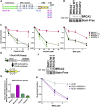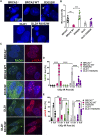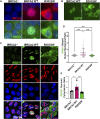The Pathogenic R3052W BRCA2 Variant Disrupts Homology-Directed Repair by Failing to Localize to the Nucleus
- PMID: 35711920
- PMCID: PMC9197106
- DOI: 10.3389/fgene.2022.884210
The Pathogenic R3052W BRCA2 Variant Disrupts Homology-Directed Repair by Failing to Localize to the Nucleus
Abstract
The BRCA2 germline missense variant, R3052W, resides in the DNA binding domain and has been previously classified as a pathogenic allele. In this study, we sought to determine how R3052W alters the cellular functions of BRCA2 in the DNA damage response. The BRCA2 R3052W mutated protein exacerbates genome instability, is unable to rescue homology-directed repair, and fails to complement cell survival following exposure to PARP inhibitors and crosslinking drugs. Surprisingly, despite anticipated defects in DNA binding or RAD51-mediated DNA strand exchange, the BRCA2 R3052W protein mislocalizes to the cytoplasm precluding its ability to perform any DNA repair functions. Rather than acting as a simple loss-of-function mutation, R3052W behaves as a dominant negative allele, likely by sequestering RAD51 in the cytoplasm.
Keywords: BRCA2; DNA repair; DSS1; R3052W; RAD51; homology-directed repair; nuclear localization.
Copyright © 2022 Jimenez-Sainz, Krysztofiak, Garbarino, Rogers and Jensen.
Conflict of interest statement
The authors declare that the research was conducted in the absence of any commercial or financial relationships that could be construed as a potential conflict of interest.
Figures





Similar articles
-
BRCA2 BRC missense variants disrupt RAD51-dependent DNA repair.Elife. 2022 Sep 13;11:e79183. doi: 10.7554/eLife.79183. Elife. 2022. PMID: 36098506 Free PMC article.
-
Defects in recombination activity caused by somatic and germline mutations in the multimerization/BRCA2 binding region of human RAD51 protein.DNA Repair (Amst). 2017 Dec;60:64-76. doi: 10.1016/j.dnarep.2017.10.008. Epub 2017 Oct 23. DNA Repair (Amst). 2017. PMID: 29100040 Free PMC article.
-
A Functional Analysis of the Unclassified Pro2767Ser BRCA2 Variant Reveals Its Potential Pathogenicity that Acts by Hampering DNA Binding and Homology-Mediated DNA Repair.Cancers (Basel). 2019 Sep 28;11(10):1454. doi: 10.3390/cancers11101454. Cancers (Basel). 2019. PMID: 31569370 Free PMC article.
-
Homologous Recombination Defects and Mutations in DNA Damage Response (DDR) Genes Besides BRCA1 and BRCA2 as Breast Cancer Biomarkers for PARP Inhibitors and Other DDR Targeting Therapies.Anticancer Res. 2023 Mar;43(3):967-981. doi: 10.21873/anticanres.16241. Anticancer Res. 2023. PMID: 36854505 Review.
-
BRCA2: one small step for DNA repair, one giant protein purified.Yale J Biol Med. 2013 Dec 13;86(4):479-89. Yale J Biol Med. 2013. PMID: 24348212 Free PMC article. Review.
Cited by
-
Characterization of BRCA2 R3052Q variant in mice supports its functional impact as a low-risk variant.Cell Death Dis. 2023 Nov 18;14(11):753. doi: 10.1038/s41419-023-06289-8. Cell Death Dis. 2023. PMID: 37980415 Free PMC article.
-
BRCA2 BRC missense variants disrupt RAD51-dependent DNA repair.Elife. 2022 Sep 13;11:e79183. doi: 10.7554/eLife.79183. Elife. 2022. PMID: 36098506 Free PMC article.
-
Olaparib-Resistant BRCA2MUT Ovarian Cancer Cells with Restored BRCA2 Abrogate Olaparib-Induced DNA Damage and G2/M Arrest Controlled by the ATR/CHK1 Pathway for Survival.Cells. 2023 Mar 29;12(7):1038. doi: 10.3390/cells12071038. Cells. 2023. PMID: 37048111 Free PMC article.
References
-
- Ban S., Shinohara T., Hirai Y., Moritaku Y., Cologne J. B., Macphee D. G. (2001). Chromosomal Instability in BRCA1- or BRCA2-Defective Human Cancer Cells Detected by Spontaneous Micronucleus Assay. Mutat Res. 474, 15–23. - PubMed
Grants and funding
LinkOut - more resources
Full Text Sources
Research Materials
Miscellaneous

